ECO mode FORD SIERRA 1985 1.G Introduction Workshop Manual
[x] Cancel search | Manufacturer: FORD, Model Year: 1985, Model line: SIERRA, Model: FORD SIERRA 1985 1.GPages: 18, PDF Size: 0.5 MB
Page 1 of 18
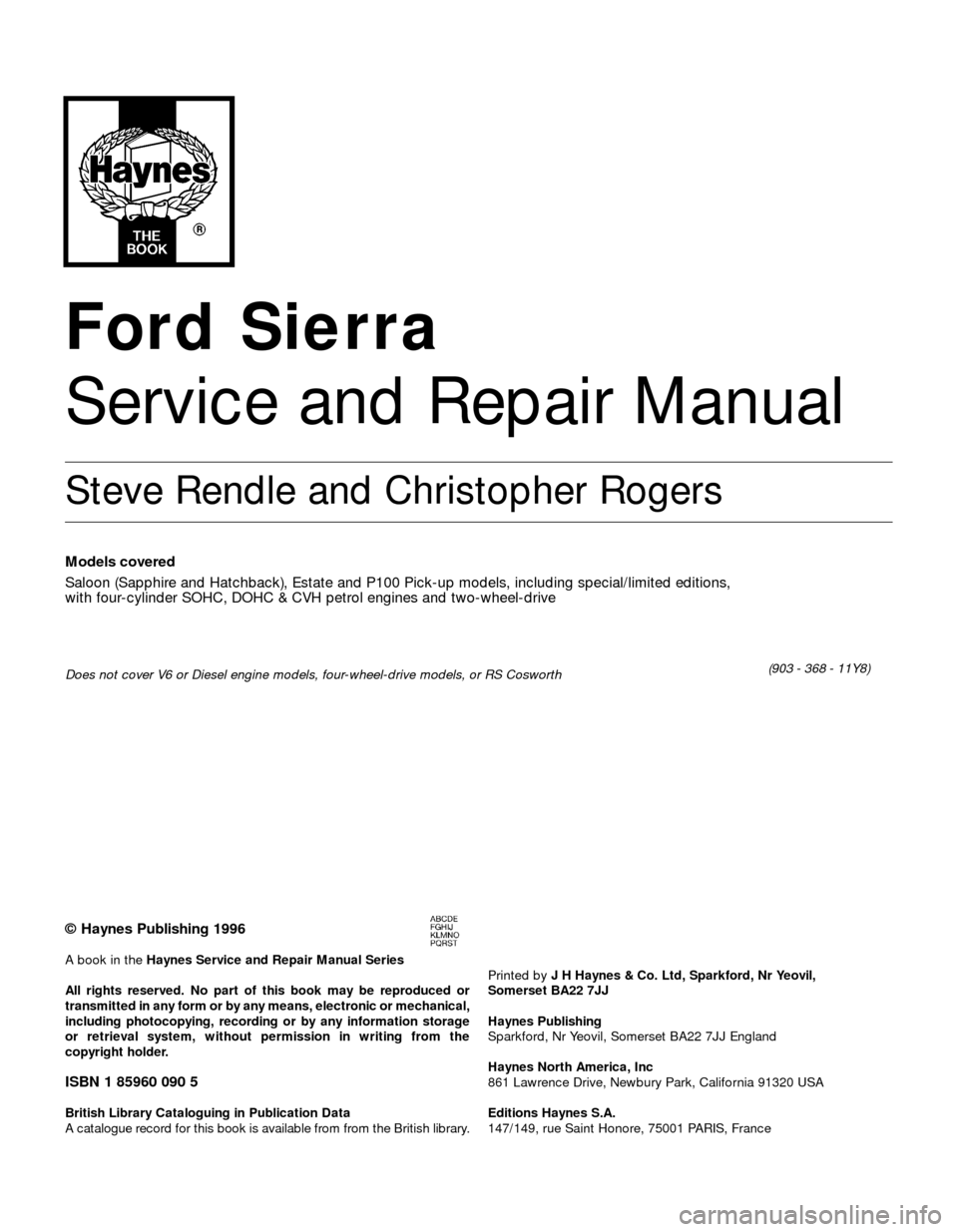
Ford Sierra
Service and Repair Manual
Steve Rendle and Christopher Rogers
Models covered
Saloon (Sapphire and Hatchback), Estate and P100 Pick-up models, including special/limited editions,
with four-cylinder SOHC, DOHC & CVH petrol engines and two-wheel-drive
Does not cover V6 or Diesel engine models, four-wheel-drive models, or RS Cosworth(903 - 368 - 11Y8)
© Haynes Publishing 1996
A book in the Haynes Service and Repair Manual Series
All rights reserved. No part of this book may be reproduced or
transmitted in any form or by any means, electronic or mechanical,
including photocopying, recording or by any information storage
or retrieval system, without permission in writing from the
copyright holder.
ISBN 1 85960 090 5
British Library Cataloguing in Publication Data
A catalogue record for this book is available from from the British library.Printed by J H Haynes & Co. Ltd, Sparkford, Nr Yeovil,
Somerset BA22 7JJ
Haynes Publishing
Sparkford, Nr Yeovil, Somerset BA22 7JJ England
Haynes North America, Inc
861 Lawrence Drive, Newbury Park, California 91320 USA
Editions Haynes S.A.
147/149, rue Saint Honore, 75001 PARIS, France
Page 4 of 18
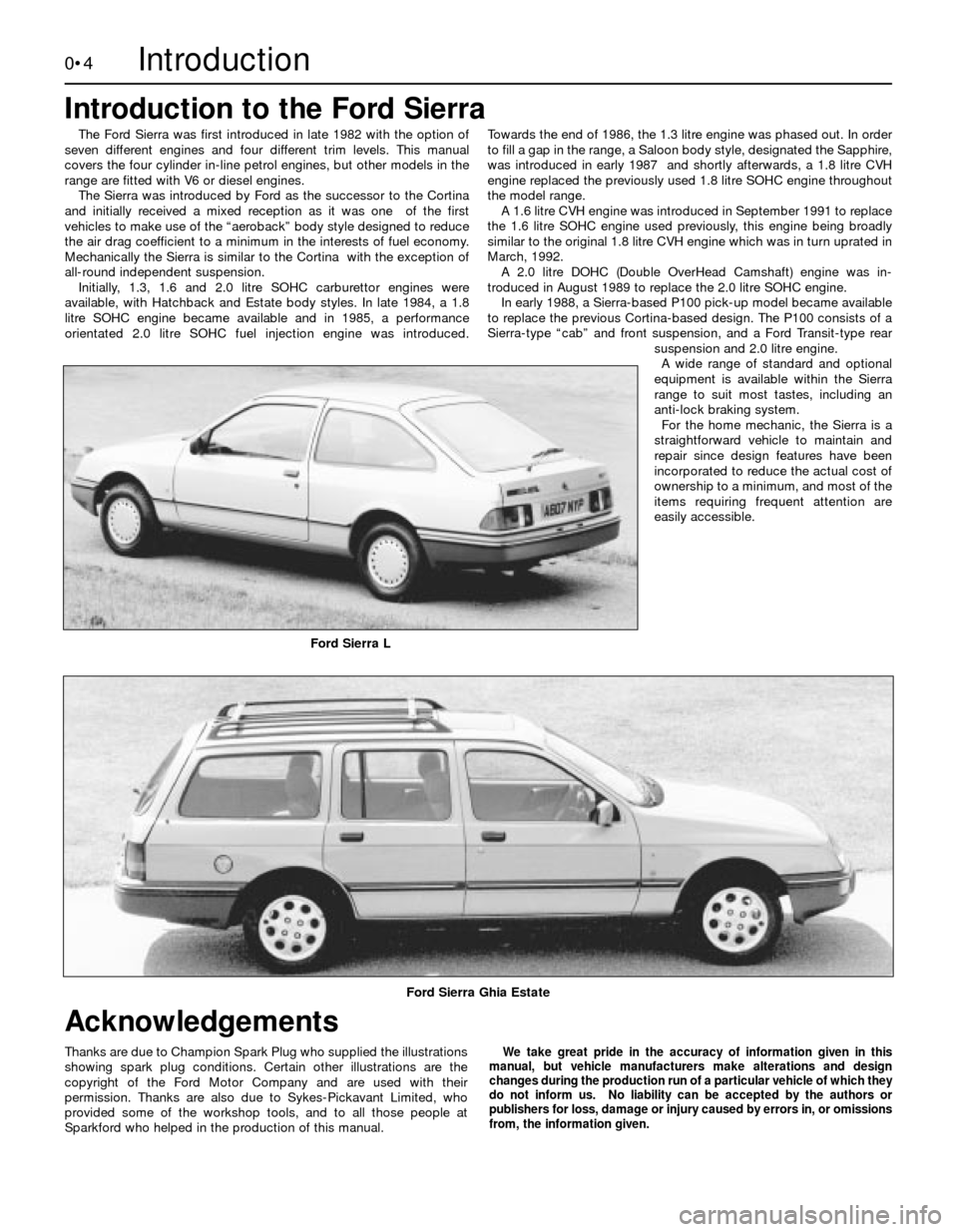
0•4
The Ford Sierra was first introduced in late 1982 with the option of
seven different engines and four different trim levels. This manual
covers the four cylinder in-line petrol engines, but other models in the
range are fitted with V6 or diesel engines.
The Sierra was introduced by Ford as the successor to the Cortina
and initially received a mixed reception as it was one of the first
vehicles to make use of the “aeroback” body style designed to reduce
the air drag coefficient to a minimum in the interests of fuel economy.
Mechanically the Sierra is similar to the Cortina with the exception of
all-round independent suspension.
Initially, 1.3, 1.6 and 2.0 litre SOHC carburettor engines were
available, with Hatchback and Estate body styles. In late 1984, a 1.8
litre SOHC engine became available and in 1985, a performance
orientated 2.0 litre SOHC fuel injection engine was introduced.Towards the end of 1986, the 1.3 litre engine was phased out. In order
to fill a gap in the range, a Saloon body style, designated the Sapphire,
was introduced in early 1987 and shortly afterwards, a 1.8 litre CVH
engine replaced the previously used 1.8 litre SOHC engine throughout
the model range.
A 1.6 litre CVH engine was introduced in September 1991 to replace
the 1.6 litre SOHC engine used previously, this engine being broadly
similar to the original 1.8 litre CVH engine which was in turn uprated in
March, 1992.
A 2.0 litre DOHC (Double OverHead Camshaft) engine was in-
troduced in August 1989 to replace the 2.0 litre SOHC engine.
In early 1988, a Sierra-based P100 pick-up model became available
to replace the previous Cortina-based design. The P100 consists of a
Sierra-type “cab” and front suspension, and a Ford Transit-type rear
suspension and 2.0 litre engine.
A wide range of standard and optional
equipment is available within the Sierra
range to suit most tastes, including an
anti-lock braking system.
For the home mechanic, the Sierra is a
straightforward vehicle to maintain and
repair since design features have been
incorporated to reduce the actual cost of
ownership to a minimum, and most of the
items requiring frequent attention are
easily accessible.
Ford Sierra L
Ford Sierra Ghia Estate
Introduction
We take great pride in the accuracy of information given in this
manual, but vehicle manufacturers make alterations and design
changes during the production run of a particular vehicle of which they
do not inform us. No liability can be accepted by the authors or
publishers for loss, damage or injury caused by errors in, or omissions
from, the information given.Thanks are due to Champion Spark Plug who supplied the illustrations
showing spark plug conditions. Certain other illustrations are the
copyright of the Ford Motor Company and are used with their
permission. Thanks are also due to Sykes-Pickavant Limited, who
provided some of the workshop tools, and to all those people at
Sparkford who helped in the production of this manual.
Introduction to the Ford Sierra
Acknowledgements
Page 12 of 18
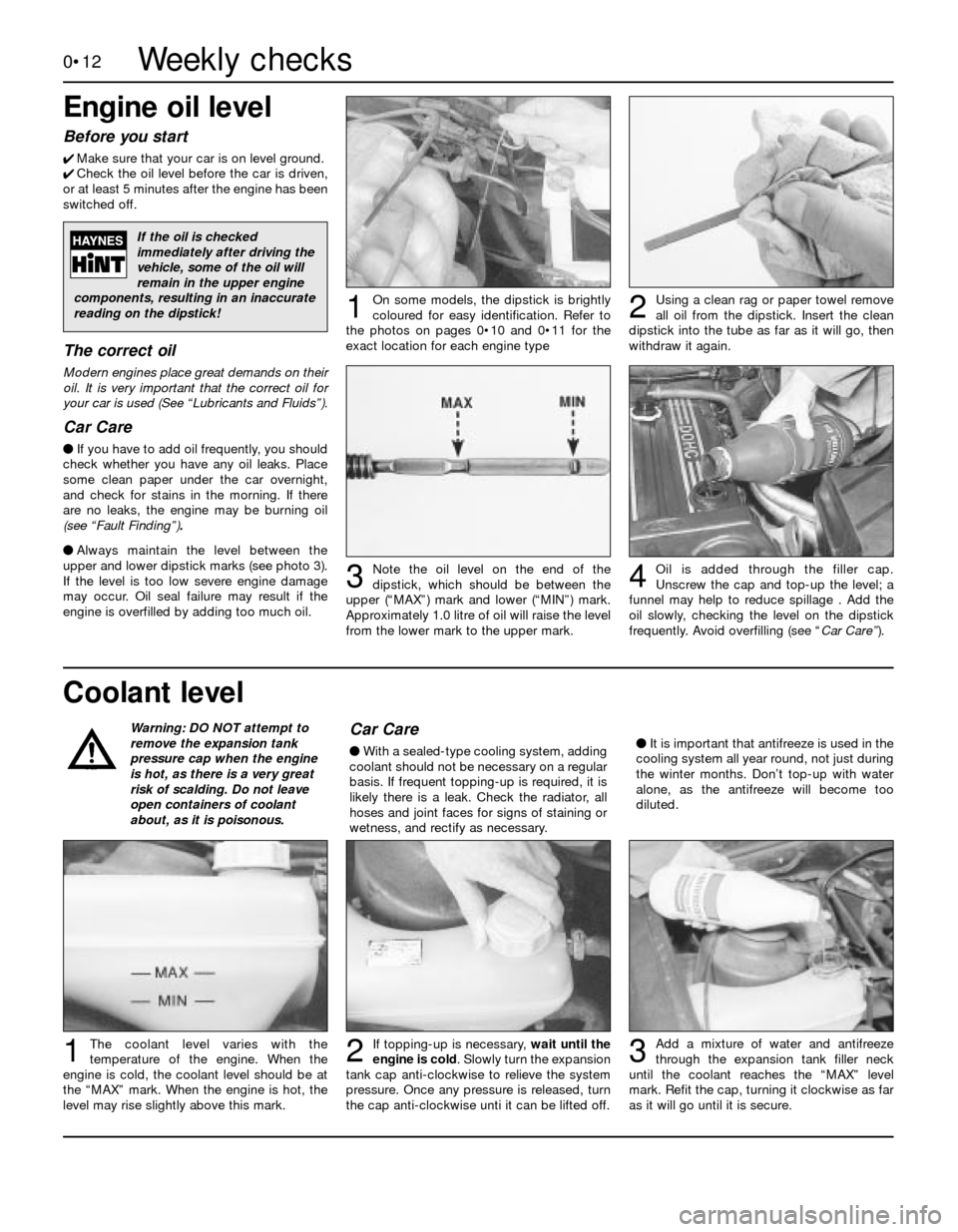
Coolant level Engine oil level
Before you start
4Make sure that your car is on level ground.
4Check the oil level before the car is driven,
or at least 5 minutes after the engine has been
switched off.
The correct oil
Modern engines place great demands on their
oil. It is very important that the correct oil for
your car is used (See “Lubricants and Fluids”).
Car Care
l If you have to add oil frequently, you should
check whether you have any oil leaks. Place
some clean paper under the car overnight,
and check for stains in the morning. If there
are no leaks, the engine may be burning oil
(see “Fault Finding”).
lAlways maintain the level between the
upper and lower dipstick marks (see photo 3).
If the level is too low severe engine damage
may occur. Oil seal failure may result if the
engine is overfilled by adding too much oil.
0•12
Using a clean rag or paper towel remove
all oil from the dipstick. Insert the clean
dipstick into the tube as far as it will go, then
withdraw it again.
Add a mixture of water and antifreeze
through the expansion tank filler neck
until the coolant reaches the “MAX” level
mark. Refit the cap, turning it clockwise as far
as it will go until it is secure.
If topping-up is necessary, wait until the
engine is cold. Slowly turn the expansion
tank cap anti-clockwise to relieve the system
pressure. Once any pressure is released, turn
the cap anti-clockwise unti it can be lifted off.The coolant level varies with the
temperature of the engine. When the
engine is cold, the coolant level should be at
the “MAX” mark. When the engine is hot, the
level may rise slightly above this mark.
Note the oil level on the end of the
dipstick, which should be between the
upper (“MAX”) mark and lower (“MIN”) mark.
Approximately 1.0 litre of oil will raise the level
from the lower mark to the upper mark.Oil is added through the filler cap.
Unscrew the cap and top-up the level; a
funnel may help to reduce spillage . Add the
oil slowly, checking the level on the dipstick
frequently. Avoid overfilling (see “Car Care”).
On some models, the dipstick is brightly
coloured for easy identification. Refer to
the photos on pages 0•10 and 0•11 for the
exact location for each engine type12
3
123
4
Warning: DO NOT attempt to
remove the expansion tank
pressure cap when the engine
is hot, as there is a very great
risk of scalding. Do not leave
open containers of coolant
about, as it is poisonous.Car Care
lWith a sealed-type cooling system, adding
coolant should not be necessary on a regular
basis. If frequent topping-up is required, it is
likely there is a leak. Check the radiator, all
hoses and joint faces for signs of staining or
wetness, and rectify as necessary.lIt is important that antifreeze is used in the
cooling system all year round, not just during
the winter months. Don’t top-up with water
alone, as the antifreeze will become too
diluted.
If the oil is checked
immediately after driving the
vehicle, some of the oil will
remain in the upper engine
components, resulting in an inaccurate
reading on the dipstick!
Weekly checks
Page 13 of 18
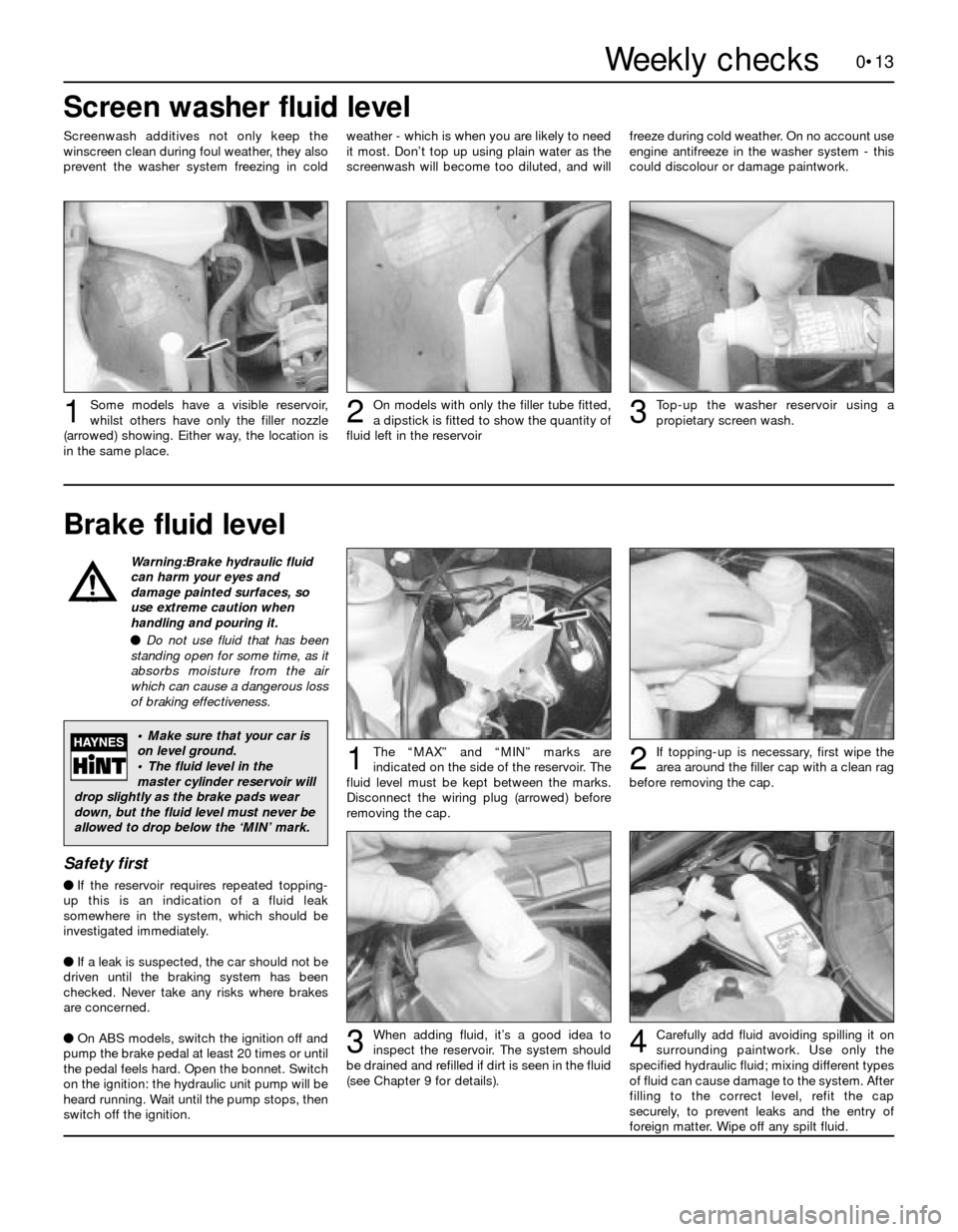
Warning:Brake hydraulic fluid
can harm your eyes and
damage painted surfaces, so
use extreme caution when
handling and pouring it.
l Do not use fluid that has been
standing open for some time, as it
absorbs moisture from the air
which can cause a dangerous loss
of braking effectiveness.
Safety first
lIf the reservoir requires repeated topping-
up this is an indication of a fluid leak
somewhere in the system, which should be
investigated immediately.
lIf a leak is suspected, the car should not be
driven until the braking system has been
checked. Never take any risks where brakes
are concerned.
lOn ABS models, switch the ignition off and
pump the brake pedal at least 20 times or until
the pedal feels hard. Open the bonnet. Switch
on the ignition: the hydraulic unit pump will be
heard running. Wait until the pump stops, then
switch off the ignition.
Brake fluid level
0•13
Carefully add fluid avoiding spilling it on
surrounding paintwork. Use only the
specified hydraulic fluid; mixing different types
of fluid can cause damage to the system. After
filling to the correct level, refit the cap
securely, to prevent leaks and the entry of
foreign matter. Wipe off any spilt fluid.When adding fluid, it’s a good idea to
inspect the reservoir. The system should
be drained and refilled if dirt is seen in the fluid
(see Chapter 9 for details).
The “MAX” and “MIN” marks are
indicated on the side of the reservoir. The
fluid level must be kept between the marks.
Disconnect the wiring plug (arrowed) before
removing the cap.1If topping-up is necessary, first wipe the
area around the filler cap with a clean rag
before removing the cap.2
34
Screen washer fluid level
Some models have a visible reservoir,
whilst others have only the filler nozzle
(arrowed) showing. Either way, the location is
in the same place.Top-up the washer reservoir using a
propietary screen wash.On models with only the filler tube fitted,
a dipstick is fitted to show the quantity of
fluid left in the reservoir
Screenwash additives not only keep the
winscreen clean during foul weather, they also
prevent the washer system freezing in coldweather - which is when you are likely to need
it most. Don’t top up using plain water as the
screenwash will become too diluted, and willfreeze during cold weather. On no account use
engine antifreeze in the washer system - this
could discolour or damage paintwork.
123
• Make sure that your car is
on level ground.
• The fluid level in the
master cylinder reservoir will
drop slightly as the brake pads wear
down, but the fluid level must never be
allowed to drop below the ‘MIN’ mark.
Weekly checks
Page 16 of 18
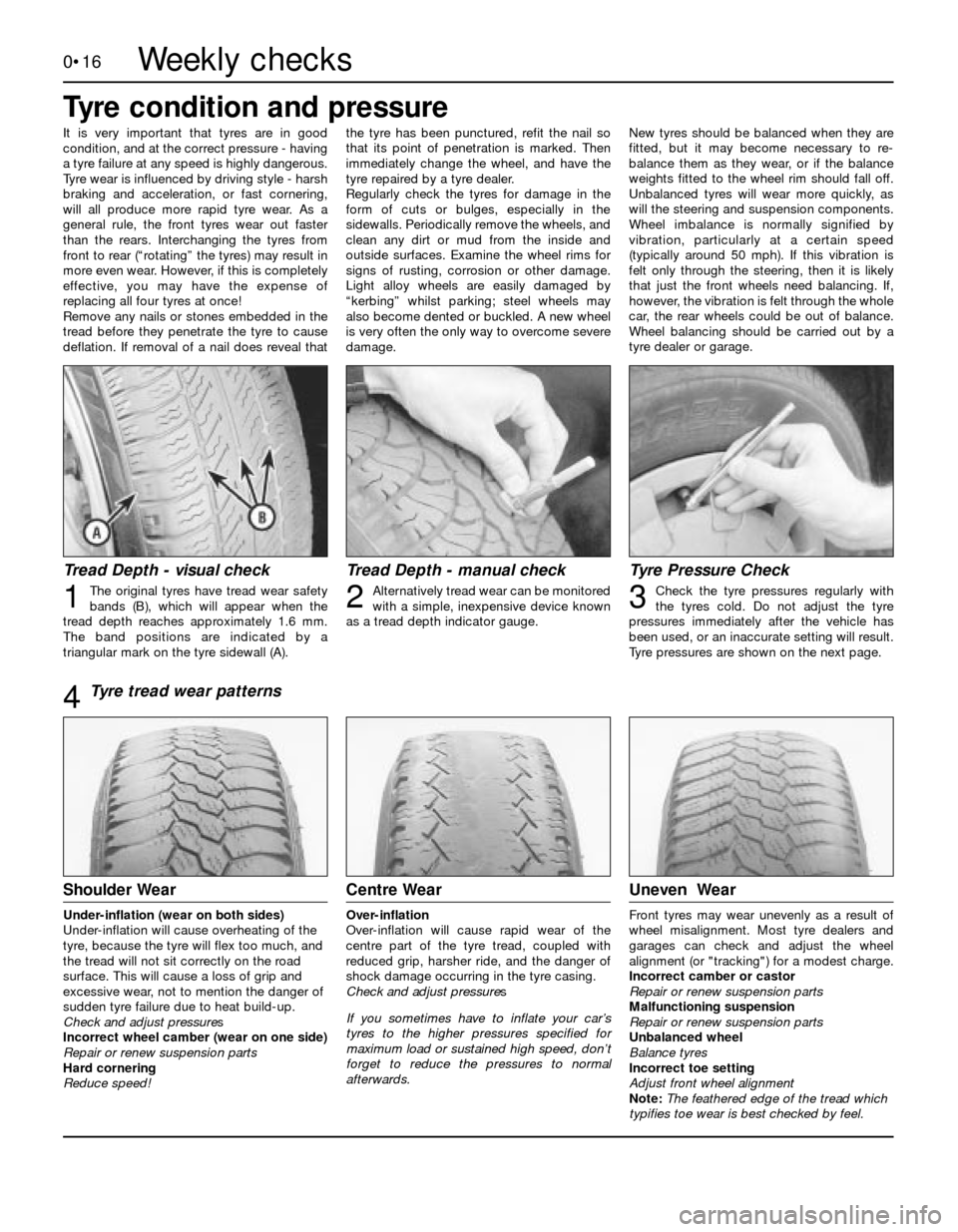
0•16Weekly checks
It is very important that tyres are in good
condition, and at the correct pressure - having
a tyre failure at any speed is highly dangerous.
Tyre wear is influenced by driving style - harsh
braking and acceleration, or fast cornering,
will all produce more rapid tyre wear. As a
general rule, the front tyres wear out faster
than the rears. Interchanging the tyres from
front to rear (“rotating” the tyres) may result in
more even wear. However, if this is completely
effective, you may have the expense of
replacing all four tyres at once!
Remove any nails or stones embedded in the
tread before they penetrate the tyre to cause
deflation. If removal of a nail does reveal thatthe tyre has been punctured, refit the nail so
that its point of penetration is marked. Then
immediately change the wheel, and have the
tyre repaired by a tyre dealer.
Regularly check the tyres for damage in the
form of cuts or bulges, especially in the
sidewalls. Periodically remove the wheels, and
clean any dirt or mud from the inside and
outside surfaces. Examine the wheel rims for
signs of rusting, corrosion or other damage.
Light alloy wheels are easily damaged by
“kerbing” whilst parking; steel wheels may
also become dented or buckled. A new wheel
is very often the only way to overcome severe
damage.New tyres should be balanced when they are
fitted, but it may become necessary to re-
balance them as they wear, or if the balance
weights fitted to the wheel rim should fall off.
Unbalanced tyres will wear more quickly, as
will the steering and suspension components.
Wheel imbalance is normally signified by
vibration, particularly at a certain speed
(typically around 50 mph). If this vibration is
felt only through the steering, then it is likely
that just the front wheels need balancing. If,
however, the vibration is felt through the whole
car, the rear wheels could be out of balance.
Wheel balancing should be carried out by a
tyre dealer or garage.
Tyre Pressure Check
Check the tyre pressures regularly with
the tyres cold. Do not adjust the tyre
pressures immediately after the vehicle has
been used, or an inaccurate setting will result.
Tyre pressures are shown on the next page.
Tread Depth - manual check
Alternatively tread wear can be monitored
with a simple, inexpensive device known
as a tread depth indicator gauge.
Tread Depth - visual check
The original tyres have tread wear safety
bands (B), which will appear when the
tread depth reaches approximately 1.6 mm.
The band positions are indicated by a
triangular mark on the tyre sidewall (A).123
Tyre condition and pressure
Tyre tread wear patterns
Shoulder Wear
Under-inflation (wear on both sides)
Under-inflation will cause overheating of the
tyre, because the tyre will flex too much, and
the tread will not sit correctly on the road
surface. This will cause a loss of grip and
excessive wear, not to mention the danger of
sudden tyre failure due to heat build-up.
Check and adjust pressures
Incorrect wheel camber (wear on one side)
Repair or renew suspension parts
Hard cornering
Reduce speed!
Centre Wear
Over-inflation
Over-inflation will cause rapid wear of the
centre part of the tyre tread, coupled with
reduced grip, harsher ride, and the danger of
shock damage occurring in the tyre casing.
Check and adjust pressures
If you sometimes have to inflate your car’s
tyres to the higher pressures specified for
maximum load or sustained high speed, don’t
forget to reduce the pressures to normal
afterwards.
Uneven Wear
Front tyres may wear unevenly as a result of
wheel misalignment. Most tyre dealers and
garages can check and adjust the wheel
alignment (or "tracking") for a modest charge.
Incorrect camber or castor
Repair or renew suspension parts
Malfunctioning suspension
Repair or renew suspension parts
Unbalanced wheel
Balance tyres
Incorrect toe setting
Adjust front wheel alignment
Note: The feathered edge of the tread which
typifies toe wear is best checked by feel.
4
Page 18 of 18

0•18Weekly checks
Note: Manufacturers often modify tyre sizes and pressure recommendations. The following is intended as a guide only. Refer to your vehicle
handbook or a Ford dealer for the latest recommendations
Tyre pressures (cold) - lbf/in2
(bar):FrontRear
All Saloon, Hatchback and Estate models with normal load*26 (1.8)26 (1.8)
All Saloon and Hatchback models with full load . . . . .29 (2.0)36 (2.5)
Estate models with full load:
175 R 13H, 175 R 135,175 R 13T, 195/70 R 13H and
195/65 R14T tyres . . . . . . . . . . . . . . . . . . . . . . . . .29 (2.0)48 (2.8)
195/60 R 14H and 195/60 VR 14 tyres . . . . . . . . . .29 (2.0)36 (2.5)
P100 models with light load . . . . . . . . . . . . . . . . . . . .26 (1.8)36 (2.5)
P100 models with full load . . . . . . . . . . . . . . . . . . . . .50 (3.5)65 (4.5)
*Normal load is defined as up to three passengers (or equivalent). For sustained high speeds add 1.5 lbf/in2
(0.1 bar) for every 6 mph (10 km/h)
over 100 mph (160 km/h)
A light load is defined as one passenger plus up to 100 kg (220 lb) payload
Tyre pressures